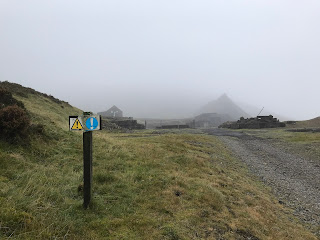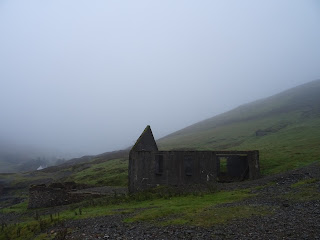On a chilly, damp and dreich day, I took to the winding roads up to the highest village in Scotland. Not a wee place in the Highlands as you might suspect, but rather in the rolling hills and glens of Dumfries and Galloway. The village of Wanlockhead, as well as laying claim to being the highest in Scotland, is a place with a past deeply entrenched in the old industry of mining. The mining of lead. And on any walk around or out of the village you will come across the remains of buildings or machines connected to mining.
After popping into the Museum of Lead Mining
for a stroll around and a coffee, I took a walk out of the village to one of the
old mines. As I
walked, the mist rolled in from the hills around me giving the landscape an
eerie quality. It made
me feel like I was walking through a scene in an old black and white thriller
and also reminded me of a tale I’d just come across in the museum about the Wanlockhead
ghost. And I do like a good
ghost story. The tale
goes that in the winter of 1877 a teenage girl called Jenny Miller set out from
a farm a few miles away to attend her sister’s wedding at Wanlockhead.
On
her back Jenny carried a wicker basket in which was a teapot she had bought
with her hard earned savings as a wedding present for her sister.
As
she walked over the hills a blizzard came in.
Determined
to get to the wedding, Jenny battled her way
through the snow and freezing winter wind, but unable to see where she was going,
lost her way and stumbled and fell into an old mine working.
Trapped
there, she succumbed to her injuries from the fall and the cold of the brutal
winter weather. For several
days her family and friends searched for her, eventually finding her poor, frozen corpse where she had fallen. A cairn was then built
nearby in her memory, and on top of the cairn was placed a stone with Jenny’s
name on it.
Around a hundred years later a visitor
to the area was taking a summer stroll through the hills when the swirling
mists suddenly descended. He then saw
a young woman walking towards him with a wicker basket on her back.
As
she approached him, he could see that she was wearing very old fashioned
clothes and appeared to be quite distressed.
He
walked towards her to ask if she was okay and heard her say - look in the
stones. She then disappeared
into the mist. Baffled
by this the visitor, on his return to the village of Wanlockhead, recounted his
tale to some locals who told him about Jenny Miller and the cairn built for
her. They then took him out
to the cairn, though could not see the stone with Jenny’s name carved on it.
Remembering
that Jenny had said to look in the stones, the visitor did, and he found the
stone with Jenny’s name on it in there, broken in two.
The stone now sits in the Museum of Lead
Mining next to a mannequin of poor Jenny Miller, whose forlorn and lonely ghost
wanders forever lost in the mists of the hills.
***
A couple of kilometres out of the
village I came to the ruined buildings and slag heaps of the New Glencrieff
Mine. As I walked around it
the silence and grey light of the mist gave it an almost dreamscape quality.
You
could imagine it being the sort of place you might just bump into a ghost or
two.
Workings at the New Glencrieff Mine
began in 1718 and various companies then utilised it throughout the years to
extract huge amounts of lead. One of
the shafts of the mine extends down 240 fathoms (around 1440 feet or 440
metres), which is pretty bloody deep.
The
mine closed in 1931 and then re-opened again for a brief period in the 1950s.
It
was the last mine to close in Wanlockhead, and over its lifetime it was
reckoned that over 105,000 tonnes of lead had been extracted and smelted from
it.
I left the Skulferatu that accompanied me on my walk in a hole in the wall of one of the ruined mine buildings.
The coordinates for the location of the Skulferatu
are –
Latitude 55.400310
Longitude -3.795050
I used the following sources for information on the tale of Jenny Miller and New Glencrieff Mine –
Museum of Lead Mining, Wanlockhead,
Dumfries and Galloway
https://www.leadminingmuseum.co.uk/
Tourist Info at the site






















